A Luminescent Proton Conductor Based on Dy2 SMM
Abstract
1. Introduction
2. Experimental Section
2.1. Materials and Instruments
2.2. Synthesis of [Dy2(1-tza)4(phen)4]∙(ClO4)2∙(H2O)2 (1)
2.3. X-Ray Single-Crystal Structure Determination
3. Results and Discussion
3.1. Structural Description and Discussion
3.2. Thermal Stability and UV Spectra
3.3. Magnetic Properties
3.4. Proton Conduction
3.5. Photoluminescent Properties
4. Conclusions
Supplementary Materials
Author Contributions
Funding
Data Availability Statement
Conflicts of Interest
References
- Surbella, R.G.; Reilly, D.D.; Sinnwell, M.A.; McNamara, B.K.; Sweet, L.E.; Schwantes, J.M.; Thallapally, P.K. Multifunctional Two-Dimensional Metal-Organic Frameworks for Radionuclide Sequestration and Detection. ACS Appl. Mater. Interfaces 2021, 13, 45696–45707. [Google Scholar] [CrossRef] [PubMed]
- Tripathy, S.P.; Subudhi, S.; Parida, K. Inter-MOF hybrid (IMOFH): A concise analysis on emerging core-shell based hierarchical and multifunctional nanoporous materials. Coord. Chem. Rev. 2021, 434, 213786. [Google Scholar] [CrossRef]
- Sherman, D.A.; Murase, R.; Duyker, S.G.; Gu, Q.Y.; Lewis, W.; Lu, T.; Liu, Y.; D’Alessandro, D.M. Reversible single crystal-to-single crystal double [2+2] cycloaddition induces multifunctional photo-mechano-electrochemical properties in framework materials. Nat. Commun. 2020, 11, 2808. [Google Scholar] [CrossRef] [PubMed]
- Lysova, A.A.; Samsonenko, D.G.; Dorovatovskii, P.V.; Lazarenko, V.A.; Khrustalev, V.N.; Kovalenko, K.A.; Dybtsev, D.N.; Fedin, V.P. Tuning the Molecular and Cationic Affinity in a Series of Multifunctional Metal-Organic Frameworks Based on Dodecanuclear Zn(II) Carboxylate Wheels. J. Am. Chem. Soc. 2019, 141, 17260–17269. [Google Scholar] [CrossRef] [PubMed]
- Gong, W.; Chen, Z.J.; Dong, J.Q.; Liu, Y.; Cui, Y. Chiral Metal-Organic Frameworks. Chem. Rev. 2022, 122, 9078–9144. [Google Scholar] [CrossRef] [PubMed]
- Zhu, Q.L.; Xu, Q. Metal-organic framework composites, Chem. Soc. Rev. 2014, 43, 5468–5512. [Google Scholar] [CrossRef] [PubMed]
- Zhang, K.Y.; Yu, Q.; Wei, H.J.; Liu, S.J.; Zhao, Q.; Huang, W. Long-Lived Emissive Probes for Time-Resolved Photoluminescence Bioimaging and Biosensing. Chem. Rev. 2018, 118, 1770–1839. [Google Scholar] [CrossRef] [PubMed]
- Galico, D.A.; Kitos, A.; Ovens, J.S.; Sigoli, F.A.; Murugesu, M. Lanthanide-Based Molecular Cluster-Aggregates: Optical Barcoding and White-Light Emission with Nanosized Ln20 Compounds. Angew. Chem. Int. Ed. 2021, 60, 6130–6136. [Google Scholar] [CrossRef] [PubMed]
- Zhang, W.B.; Muhtadi, A.; Iwahara, N.; Ungur, L.; Chibotaru, L.F. Magnetic anisotropy in divalent lanthanide compounds. Angew. Chem. Int. Ed. 2020, 59, 12720–12724. [Google Scholar] [CrossRef]
- Su, J.; Xu, N.; Murase, R.; Yang, Z.M.; D’Alessandro, D.M.; Zuo, J.L.; Zhu, J. Persistent Radical Tetrathiafulvalene-Based 2D Metal-Organic Frameworks and Their Application in Efficient Photothermal Conversion. Angew. Chem. Int. Ed. 2021, 60, 4789–4795. [Google Scholar] [CrossRef]
- Kovacs, D.; Lu, X.L.; Meszaros, S.M.; Ott, M.; Andres, J.; Borbas, K.E. Photophysics of Coumarin and Carbostyril-Sensitized Luminescent Lanthanide Complexes: Implications for Complex Design in Multiplex Detection. J. Am. Chem. Soc. 2017, 139, 5756–5767. [Google Scholar] [CrossRef] [PubMed]
- Wu, Y.K.; Li, F.; Wu, Y.N.; Wang, H.; Gu, L.T.; Zhang, J.Y.; Qi, Y.K.; Meng, L.K.; Kong, N.; Chai, Y.J.; et al. Lanthanide luminescence nanothermometer with working wavelength beyond 1500 nm for cerebrovascular temperature imaging in vivo. Nat. Commun. 2024, 15, 2341. [Google Scholar] [CrossRef]
- Luo, T.Y.; Das, P.; White, D.L.; Liu, C.A.; Star and Rosi, N.L. Luminescence “Turn-On” Detection of Gossypol Using Ln3+-Based Metal-Organic Frameworks and Ln3+ Salts. J. Am. Chem. Soc. 2020, 142, 2897–2904. [Google Scholar] [CrossRef] [PubMed]
- Harriman, K.L.M.; Brosmer, J.L.; Ungur, L.; Diaconescu, P.L.; Murugesu, M. Pursuit of Record Breaking Energy Barriers: A Study of Magnetic Axiality in Diamide Ligated DyIII Single-Molecule Magnets. J. Am. Chem. Soc. 2017, 139, 1420–1423. [Google Scholar] [CrossRef] [PubMed]
- Zheng, X.Y.; Xie, J.; Kong, X.J.; Long, L.S.; Zheng, L.S. Recent advances in the assembly of high-nuclearity lanthanide clusters. Coord. Chem. Rev. 2019, 378, 222–236. [Google Scholar] [CrossRef]
- Da Cunha, T.T.; Jung, J.M.; Boulon, E.; Campo, G.; Pointillart, F.; Pereira, C.L.M.; Le Guennic, B.; Cador, O.; Bernot, K.; Pineider, F.; et al. Magnetic Poles Determinations and Robustness of Memory Effect upon Solubilization in a DyIII-Based Single Ion Magnet. J. Am. Chem. Soc. 2013, 135, 16332–16335. [Google Scholar] [CrossRef]
- Wang, H.L.; Wang, B.W.; Bian, Y.Z.; Gao, S.; Jiang, J.Z. Single-molecule magnetism of tetrapyrrole lanthanide compounds with sandwich multiple-decker structures. Coord. Chem. Rev. 2016, 306, 195–216. [Google Scholar] [CrossRef]
- Thomas-Hargreaves, L.R.; Hunger, D.; Kern, M.; Wooles, A.J.; van Slageren, J.; Chilton, N.F.; Liddle, S.T. Insights into D4h@metal-symmetry single-molecule magnetism: The case of a dysprosium-bis(boryloxide) complex. Chem. Commun. 2021, 57, 733–736. [Google Scholar] [CrossRef] [PubMed]
- Latendresse, T.P.; Bhuvanesh, N.S.; Nippe, M. Hard Single-Molecule Magnet Behavior by a Linear Trinuclear Lanthanide-[1]Metallocenophane Complex. J. Am. Chem. Soc. 2017, 139, 14877–14880. [Google Scholar] [CrossRef] [PubMed]
- Zhang, P.; Perfetti, M.; Kern, M.; Hallmen, P.P.; Ungur, L.; Lenz, S.; Ringenberg, M.R.; Frey, W.; Stoll, H.; Rauhut, G.; et al. Exchange coupling and single molecule magnetism in redox-active tetraoxolene-bridged dilanthanide complexes. Chem. Sci. 2018, 9, 1221–1230. [Google Scholar] [CrossRef] [PubMed]
- Hilgar, J.D.; Bernbeck, M.G.; Rinehart, J.D. Million-fold Relaxation Time Enhancement across a Series of Phosphino-Supported Erbium Single-Molecule Magnets. J. Am. Chem. Soc. 2019, 141, 1913–1917. [Google Scholar] [CrossRef] [PubMed]
- Zhu, Z.H.; Guo, M.; Li, X.Y.; Tang, J.K. Molecular magnetism of lanthanide: Advances and perspectives. Coord. Chem. Rev. 2019, 378, 350–364. [Google Scholar] [CrossRef]
- Pedersen, K.S.; Ariciu, A.M.; McAdams, S.; Weihe, H.; Bendix, J.; Tuna, F.; Piligkos, S. Toward Molecular 4f Single-Ion Magnet Qubits. J. Am. Chem. Soc. 2016, 138, 5801–5804. [Google Scholar] [CrossRef] [PubMed]
- Liu, J.; Chen, Y.C.; Liu, J.L.; Vieru, V.; Ungur, L.; Jia, J.H.; Chibotaru, L.F.; Lan, Y.H.; Wernsdorfer, W.; Gao, S.; et al. A Stable Pentagonal Bipyramidal Dy(III) Single-Ion Magnet with a Record Magnetization Reversal Barrier over 1000 K. J. Am. Chem. Soc. 2016, 138, 5441–5450. [Google Scholar] [CrossRef] [PubMed]
- Goodwin, C.A.P.; Ortu, F.; Reta, D.; Chilton, N.F.; Mills, D.P. Molecular magnetic hysteresis at 60 kelvin in dysprosocenium. Nature 2017, 548, 439–442. [Google Scholar] [CrossRef] [PubMed]
- Guo, F.S.; Day, B.M.; Chen, Y.C.; Tong, M.L.; Mansikkamaki, A.; Layfield, R.A. Magnetic hysteresis up to 80 kelvin in a dysprosium metallocene single-molecule magnet. Science 2018, 362, 1400–1403. [Google Scholar] [CrossRef] [PubMed]
- Zhang, P.; Guo, Y.N.; Tang, J.K. Recent advances in dysprosium-based single molecule magnets: Structural overview and synthetic strategies. Coord. Chem. Rev. 2013, 257, 1728–1763. [Google Scholar] [CrossRef]
- Marin, R.; Brunet, G.; Murugesu, M. Shining new light on multifunctional lanthanide single-molecule magnets. Angew. Chem. Int. Ed. 2021, 60, 1728–1746. [Google Scholar] [CrossRef]
- Sato, T.; Breedlove, B.K.; Yamashita, M.; Katoh, K. Electro-Conductive Single-Molecule Magnet Composed of a Dysprosium(III)-Phthalocyaninato Double-Decker Complex with Magnetoresistance. Angew. Chem. Int. Ed. 2021, 60, 21179–21183. [Google Scholar] [CrossRef]
- Shen, Y.B.; Cosquer, G.; Zhang, H.T.; Breedlove, B.K.; Cui, M.X.; Yamashita, M. 4f-π Molecular Hybrid Exhibiting Rich Conductive Phases and Slow Relaxation of Magnetization. J. Am. Chem. Soc. 2021, 143, 9543–9550. [Google Scholar] [CrossRef] [PubMed]
- Zhu, Z.H.; Zhao, C.; Feng, T.T.; Liu, X.D.; Ying, X.; Li, X.L.; Zhang, Y.Q.; Tang, J.K. Air-Stable Chiral Single-Molecule Magnets with Record Anisotropy Barrier Exceeding 1800 K. J. Am. Chem. Soc. 2021, 143, 10077–10082. [Google Scholar] [CrossRef]
- Qin, L.; Yu, Y.Z.; Liao, P.Q.; Xue, W.; Zheng, Z.P.; Chen, X.M.; Zheng, Y.Z. A “Molecular Water Pipe”: A Giant Tubular Cluster {Dy72} Exhibits Fast Proton Transport and Slow Magnetic Relaxation. Adv. Mater. 2016, 28, 10772–10779. [Google Scholar] [CrossRef] [PubMed]
- Long, J.; Guari, Y.; Ferreira, R.A.S.; Carlos, L.D.; Larionova, J. Recent advances in luminescent lanthanide based Single-Molecule Magnets. Coord. Chem. Rev. 2018, 363, 57–79. [Google Scholar] [CrossRef]
- Xin, Y.; Wang, J.H.; Zychowicz, M.; Zakrzewski, J.J.; Nakabayashi, K.; Sieklucka, B.; Chorazy, S.; Ohkoshi, S. Dehydration–Hydration Switching of Single-Molecule Magnet Behavior and Visible Photoluminescence in a Cyanido-Bridged DyIIICoIII Framework. J. Am. Chem. Soc. 2019, 141, 18211–18220. [Google Scholar] [CrossRef]
- Corredoira-Vazquez, J.; Gonzalez-Barreira, C.; Garcia-Deibe, A.M.; Sanmartin-Matalobos, J.; Hernandez-Rodriguez, M.A.; Brites, C.D.S.; Carlos, L.D.; Fondo, M. Harnessing ligand design to develop primary and self-calibrated luminescent thermometers with field-induced single ion magnet behaviour in Dy3+ complexes. Inorg. Chem. Front. 2024, 11, 1087–1098. [Google Scholar] [CrossRef]
- Long, J.; Rouquette, J.; Thibaud, J.M.; Ferreira, R.A.S.; Carlos, L.D.; Donnadieu, B.; Vieru, V.; Chibotaru, L.F.; Konczewicz, L.; Haines, J.; et al. A High-Temperature Molecular Ferroelectric Zn/Dy Complex Exhibiting Single-Ion-Magnet Behavior and Lanthanide Luminescence. Angew. Chem. Int. Ed. 2015, 54, 2236–2240. [Google Scholar] [CrossRef]
- Brunet, G.; Marin, R.; Monk, M.J.; Resch-Genger, U.; Gálico, D.A.; Sigoli, F.A.; Suturina, E.A.; Hemmer, E.; Murugesu, M. Exploring the dual functionality of an ytterbium complex for luminescence thermometry and slow magnetic relaxation. Chem. Sci. 2019, 10, 6799–6808. [Google Scholar] [CrossRef]
- Errulat, D.R.; Marin, D.A.; Gálico, K.L.M.; Harriman, A.; Pialat, B.; Gabidullin, F.; Iikawa, O.D.D., Jr.; Couto, J.O.; Moilanen, E.; Hemmer, F.; et al. A luminescent thermometer exhibiting slow relaxation of the magnetization: Toward selfmonitored building blocks for next-generation optomagnetic devices. ACS Cent. Sci. 2019, 5, 1187–1198. [Google Scholar] [CrossRef]
- Guo, P.H.; Meng, Y.; Chen, Y.C.; Li, Q.W.; Wang, B.Y.; Leng, J.D.; Bao, D.H.; Jia, J.H.; Tong, M.L. A zigzag DyIII4 cluster exhibiting single-molecule magnet, ferroelectric and white-light emitting properties. J. Mater. Chem. C 2014, 42, 8858–8864. [Google Scholar] [CrossRef]
- Lim, D.W.; Kitagawa, H. Proton Transport in Metal–Organic Frameworks. Chem. Rev. 2020, 120, 8416–8467. [Google Scholar] [CrossRef] [PubMed]
- Yao, Z.Z.; Pan, L.; Liu, L.Z.; Zhang, J.D.; Lin, Q.J.; Ye, Y.X.; Zhang, Z.J.; Xiang, S.C.; Chen, B.L. Simultaneous implementation of resistive switching and rectifying effects in a metal-organic framework with switched hydrogen bond pathway. Sci. Adv. 2019, 5, eaaw4515. [Google Scholar] [CrossRef] [PubMed]
- Su, J.; He, W.; Li, X.M.; Sun, L.; Wang, H.Y.; Lan, Y.Q.; Ding, M.; Zuo, J.L. High Electrical Conductivity in a 2D MOF with Intrinsic Superprotonic Conduction and Interfacial Pseudo-capacitance. Matter 2020, 2, 711–722. [Google Scholar] [CrossRef]
- Shinde, D.B.; Aiyappa, H.B.; Bhadra, M.; Biswal, B.P.; Wadge, P.; Kandambeth, S.; Garai, B.; Kundu, T.; Kurungot, S.; Banerjee, R. A mechanochemically synthesized covalent organic framework as a proton-conducting solid electrolyte. J. Mater Chem. A. 2016, 4, 2682–2690. [Google Scholar] [CrossRef]
- Liu, S.S.; Liu, Q.Q.; Huang, S.Z.; Zhang, C.; Dong, X.Y.; Zang, S.Q. Sulfonic and phosphonic porous solids as proton conductors. Coord. Chem. Rev. 2022, 451, 214241. [Google Scholar] [CrossRef]
- Ma, X.; Wang, S.Y.; Fan, Q.H.; Wang, P.; Wang, L.; Luo, Y.J.; Du, L.; Zhao, Q.H.A. Highly Stable Multifunctional Bi-Based MOF for Rapid Visual Detection of S2- and H2S Gas with High Proton Conductivity. ACS Appl. Mater. Interfaces 2024, 16, 33865–33876. [Google Scholar] [CrossRef]
- Lee, H.K.; Oruganti, Y.; Lee, J.; Han, S.; Kim, J.; Moon, D.; Kim, M.; Lim, D.W.; Moon, H.R. Moisture-triggered proton conductivity switching in metal-organic frameworks: Role of coordinating solvents. J. Mater. Chem. A. 2024, 12, 795–801. [Google Scholar] [CrossRef]
- Kallem, P.; Drobek, M.; Julbe, A.; Vriezekolk, E.J.; Mallada, R.; Pina, M.P. Hierarchical Porous Polybenzimidazole Microsieves: An Efficient Architecture for Anhydrous Proton Transport via Polyionic Liquids. ACS Appl. Mater. Interfaces 2017, 9, 14844–14857. [Google Scholar] [CrossRef] [PubMed]
- Ji, X.Q.; Sun, R.; Xiong, J.; Sun, H.L.; Song, S. Tuning the dynamic magnetic behaviour and proton conductivity via water-induced reversible single-crystal to single-crystal structural transformation. J. Mater Chem. C 2021, 9, 15858–15867. [Google Scholar] [CrossRef]
- Li, S.J.; Zhao, Y.; Knoll, S.; Liu, R.J.; Li, G.; Peng, Q.P.; Qiu, P.T.; He, D.F.; Streb, C.; Chen, X.N.A. High Proton-Conductivity in Covalently Linked Polyoxometalate Organoboronic Acid-Polymers. Angew. Chem. Int. Ed. 2021, 60, 16953–16957. [Google Scholar] [CrossRef]
- Lim, D.W.; Sadakiyo, M.; Kitagawa, H. Proton Transfer in Hydrogen-Bonded Degenerate Systems of Water and Ammonia in Metal-Organic Frameworks. Chem. Sci. 2019, 10, 16–33. [Google Scholar] [CrossRef]
- Pal, S.C.; Das, M.C. Superprotonic Conductivity of MOFs and Other Crystalline Platforms Beyond 10−1 S c m−1. Adv. Funct. Mater. 2021, 31, 2101584. [Google Scholar] [CrossRef]
- Ye, Y.; Guo, W.; Wang, L.; Li, Z.; Song, Z.; Chen, J.; Zhang, Z.; Xiang, S.; Chen, B. Straightforward Loading of Imidazole Molecules into Metal-Organic Framework for High Proton Conduction. J. Am. Chem. Soc. 2017, 139, 15604–15607. [Google Scholar] [CrossRef] [PubMed]
- Bao, S.S.; Shimizu, G.K.H.; Zheng, L.M. Proton conductive metal phosphonate frameworks. Coord. Chem. Rev. 2019, 378, 577–594. [Google Scholar] [CrossRef]
- Xie, X.X.; Yang, Y.C.; Dou, B.H.; Li, Z.F.; Li, G. Proton conductive carboxylate-based metal-organic frameworks. Coord. Chem. Rev. 2020, 403, 213100–213132. [Google Scholar] [CrossRef]
- Ye, Y.; Zhang, L.Q.; Peng, Q.F.; Wang, G.E.; Shen, Y.; Li, Z.; Wang, L.H.; Ma, X.Y.; Chen, Q.H.; Zhang, Z.J.; et al. High Anhydrous Proton Conductivity of Imidazole-Loaded Meso-porous Polyimides over a Wide Range from Subzero to Moderate Temperature. J. Am. Chem. Soc. 2015, 137, 913–918. [Google Scholar] [CrossRef]
- Luo, H.B.; Ren, Q.; Wang, P.; Zhang, J.; Wang, L.F.; Ren, X.M. High Proton Conductivity Achieved by Encapsulation of Imidazole Molecules into Proton-Conducting MOF-808. ACS Appl. Mater. Interfaces 2019, 11, 9164–9171. [Google Scholar] [CrossRef]
- Nguyen, M.V.; Lo, T.H.N.; Luu, L.C.; Nguyen, H.T.T.; Tu, T.N. Enhancing proton conductivity in a metal-organic framework at T > 80 °C by an anchoring strategy. J. Mater. Chem. A 2018, 6, 1816–1821. [Google Scholar] [CrossRef]
- Dong, X.Y.; Li, J.J.; Han, Z.; Duan, P.G.; Li, L.K.; Zang, S.Q. Tuning the Functional Substituent Group and Guest of Metal-Organic Frameworks in Hybrid Membranes for Improved Interface Compatibility and Proton Conduction. J. Mater. Chem. A 2017, 5, 3464–3474. [Google Scholar] [CrossRef]
- Sadakiyo, M.; Ōkawa, H.; Shigematsu, A.; Ohba, M.; Yamada, T.; Kitagawa, H. Promotion of Low-Humidity Proton Conduction by Controlling Hydrophilicity in Layered Metal-Organic Frameworks. J. Am. Chem. Soc. 2012, 134, 5472–5475. [Google Scholar] [CrossRef] [PubMed]
- Okawa, H.; Sadakiyo, M.; Yamada, T.; Maesato, M.; Ohba, M.; Kitagawa, H. Proton-Conductive Magnetic Metal–Organic Frameworks, {NR3(CH2COOH)}[MaIIMbIII(ox)3]: Effect of Carboxyl Residue upon Proton Conduction. J. Am. Chem. Soc. 2013, 135, 2256–2262. [Google Scholar] [CrossRef] [PubMed]
- Wang, J.H.; Zakrzewski, J.J.; Heczko, M.; Zychowicz, M.; Nakagawa, K.; Nakabayashi, K.; Sieklucka, B.; Chorazy, S.; Ohkoshi, S. Proton Conductive Luminescent Thermometer Based on Near Infrared Emissive {YbCo2} Molecular Nanomagnets. J. Am. Chem. Soc. 2020, 142, 3970–3979. [Google Scholar] [CrossRef]
- Zhu, S.D.; Hu, J.J.; Dong, L.; Wen, H.R.; Liu, S.J.; Lu, Y.B.; Liu, C.M. Multifunctional Zn(II)–Yb(III) complex enantiomers showing second-harmonic generation, near-infrared luminescence, single-molecule magnet behaviour and proton conduction. J. Mater. Chem. C 2020, 8, 16032–16041. [Google Scholar] [CrossRef]
- Zhang, X.N.; Hu, J.J.; Zhang, J.L.; Liu, S.J.; Liao, J.S.; Wen, H.R. Multifunctional ZnII-LnIII (Ln = Tb, Dy) complexes based on the amine-phenol ligand with field-induced slow magnetic relaxation, luminescence, and proton conduction. New J. Chem. 2021, 45, 3392–3399. [Google Scholar] [CrossRef]
- Chen, J.F.; Ge, Y.L.; Wu, D.H.; Cui, H.T.; Mu, Z.L.; Xiao, H.P.; Li, X.H.; Ge, J.Y. Two-dimensional dysprosium(III) coordination polymer: Structure, single-molecule magnetic behavior, proton conduction, and luminescence. Front. Chem. 2022, 10, 974914. [Google Scholar] [CrossRef]
- Lu, Y.B.; Huang, J.; Liao, Y.Q.; Lin, X.L.; Huang, S.Y.; Liu, C.M.; Wen, H.R.; Liu, S.J.; Wang, F.Y.; Zhu, S.D. Multifunctional Dinuclear Dy-Based Coordination Complex Showing Visible Photoluminescence Single-Molecule Magnet Behavior and Proton Conduction. Inorg. Chem. 2022, 61, 18545–18553. [Google Scholar] [CrossRef]
- Zhu, S.D.; Zhou, Y.L.; Lei, Y.; Wen, H.R.; Liu, S.J.; Liu, C.M.; Zhang, S.Y.; Lu, Y.B. Combined performance of circularly polarized luminescence and proton conduction in homochiral cadmium(II)-terbium(III) complexes. Inorg. Chem. Front. 2024, 11, 1531–1539. [Google Scholar] [CrossRef]
- Zhu, S.D.; Zhou, Y.L.; Liu, F.; Lei, Y.; Liu, S.J.; Wen, H.R.; Shi, B.; Zhang, S.Y.; Liu, C.M.; Lu, Y.B. A Pair of Multifunctional Cu(II)-Dy(III) Enantiomers with Zero-Field Single-Molecule Magnet Behaviors, Proton Conduction Properties and Magneto-Optical Faraday Effects. Molecules 2023, 28, 7506. [Google Scholar] [CrossRef]
- Lu, Y.B.; Liao, Y.Q.; Dong, L.; Zhu, S.D.; Wen, H.R.; Huang, J.; Dai, X.X.; Lian, P.; Jiang, X.M.; Li, R.; et al. Ultra-Stable Metal-Organic Framework with Concurrent High Proton Conductivity and Fluorescence Sensing for Nitrobenzene. Chem. Mater. 2021, 33, 7858–7868. [Google Scholar] [CrossRef]
- Rigaku Oxford Diffraction. CrysAlisPro Software System, version v40.67a; Rigaku Corporation: Oxford, UK, 2019.
- Dolomanov, O.V.; Bourhis, L.J.; Gildea, R.J.; Howard, J.A.K.; Puschmann, H. OLEX2: A Complete Structure Solution, Refinement and Analysis Program. J. Appl. Crystallogr. 2009, 42, 339–341. [Google Scholar] [CrossRef]
- Spek, A.L. Structure validation in chemical crystallography. Acta Cryst. 2009, D65, 148–155. [Google Scholar] [CrossRef]
- Llunell, M.; Casanova, D.; Cirera, J.; Alemany, P.; Alvarez, S. SHAPE, version 2.1; Electronic Structure Group, Universitat de Barcelona: Barcelona, Spain, 2013.
- Litvinova, Y.M.; Gayfulin, Y.M.; van Leusen, J.; Samsonenko, D.G.; Lazarenko, V.A.; Zubavichus, Y.V.; Kogerler, P.; Mironov, Y.V. Metal-organic frameworks based on polynuclear lanthanide complexes and octahedral rhenium clusters. Inorg. Chem. Front. 2019, 6, 1518–1526. [Google Scholar] [CrossRef]
- Canaj, A.B.; Dey, S.; Mart, E.R.; Wilson, C.; Rajaraman, G.; Murrie, M. Insight into D6h Symmetry: Targeting Strong Axiality in Stable Dysprosium(III) Hexagonal Bipyramidal Single-Ion Magnets. Angew. Chem. Int. Ed. 2019, 58, 14146–14151. [Google Scholar] [CrossRef] [PubMed]
- Benmansour, S.; Hernández–Paredes, A.; Bayona–Andrés, M.; Gómez–García, C.J. Slow Relaxation of the Magnetization in Anilato–Based Dy(III) 2D Lattices. Molecules 2021, 26, 1190. [Google Scholar] [CrossRef] [PubMed]
- Evans, P.; Reta, D.; Chilton, G.F.S.N.F.; Mills, D.P. A Bis-Monophospholyl Dysprosium Cation Showing Magnetic Hysteresis at 48 Kelvin. J. Am. Chem. Soc. 2020, 142, 19935–19940. [Google Scholar]
- Zhang, S.; Wu, H.P.; Sun, L.; Ke, H.S.; Chen, S.P.; Wei, Q.; Yang, D.S.; Gao, S.L. Ligand field fine-tuning on the modulation of the magnetic properties and relaxation dynamics of dysprosium(III) single-ion magnets (SIMs): Synthesis, structure, magnetism and ab initio calculations. J. Mater. Chem. C 2017, 5, 1369–1382. [Google Scholar] [CrossRef]
- Ma, Y.J.; Hu, J.X.; Han, S.D.; Pan, J.; Li, J.H.; Wang, G.M. Manipulating On/Off Single-Molecule Magnet Behavior in a Dy(III)-Based Photochromic Complex. J. Am. Chem. Soc. 2020, 142, 2682–2689. [Google Scholar] [CrossRef]
- Sun, L.; Wei, S.L.; Zhang, J.; Wang, W.Y.; Chen, S.P.; Zhang, Y.Q.; Wei, Q.; Xie, G.; Gao, S.L. Isomeric ligand enhancing the anisotropy barrier within nine-coordinated {Dy2} Compounds. J. Mater. Chem. C 2017, 5, 9488–9495. [Google Scholar] [CrossRef]
- Blagg, R.J.; Muryn, C.A.; McInnes, E.J.L.; Tuna, F.; Winpenny, R.E.P. Single Pyramid Magnets: Dy5 Pyramids with Slow Magnetic Relaxation to 40 K. Angew. Chem. Int. Ed. 2011, 50, 6530–6533. [Google Scholar] [CrossRef] [PubMed]
- Yu, S.; Hu, H.C.; Chen, Y.K.; Chen, Z.L.; Zhang, Z.Y.; Ding, M.M.; Zhang, Y.Q.; Liu, D.C.; Liang, Y.N.; Liang, F.P. Acid and alkali-resistant Dy4 coordination clusters: Synthesis, structure and slow magnetic relaxation behaviors. J. Mater. Chem. C 2021, 9, 3854–3862. [Google Scholar] [CrossRef]
- Umeyama, D.; Horike, S.; Inukai, M.; Itakura, T.; Kitagawa, S. Inherent Proton Conduction in a 2D Coordination Framework. J. Am. Chem. Soc. 2012, 134, 12780–12785. [Google Scholar] [CrossRef]
- Ohkoshi, S.; Nakagawa, K.; Imoto, K.; Tokoro, H.; Shibata, Y.; Okamoto, K.; Miyamoto, Y.; Komine, M.; Yoshikiyo, M.; Namai, A. A photoswitchable polar crystal that exhibits superionic conduction. Nat. Chem. 2020, 12, 338–344. [Google Scholar] [CrossRef] [PubMed]
- Sadakiyo, M.; Yamada, T.; Honda, K.; Matsui, H.; Kitagawa, H. Control of Crystalline Proton-Conducting Pathways by Water-Induced Transformations of Hydrogen-Bonding Networks in A Metal-Organic Framework. J. Am. Chem. Soc. 2014, 136, 7701–7707. [Google Scholar] [CrossRef]
- Kim, S.; Joarder, B.; Hurd, J.; Zhang, J.; Dawson, K.W.; Gelfand, B.S.; Wong, N.E.; Shimizu, G.K.H. Achieving Superprotonic Conduction in Metal-Organic Frameworks through Iterative Design Advances. J. Am. Chem. Soc. 2018, 140, 1077–1082. [Google Scholar] [CrossRef]
- Zhang, F.M.; Dong, L.Z.; Qin, J.S.; Guan, W.; Liu, J.; Li, S.L.; Lu, M.; Lan, Y.Q.; Su, Z.M.; Zhou, H.C. Effect of Imidazole Arrangements on Proton-Conductivity in Metal-Organic Frameworks. J. Am. Chem. Soc. 2017, 139, 6183–6189. [Google Scholar] [CrossRef] [PubMed]
- Zou, X.N.; Zhang, D.S.; Xie, Y.L.; Luan, T.X.; Li, W.C.; Li, L.; Li, P.Z. High Enhancement in Proton Conductivity by Incorporating Sulfonic Acids into a Zirconium-Based Metal-Organic Framework via “Click” Reaction. Inorg. Chem. 2021, 60, 10089–10094. [Google Scholar] [CrossRef]
- Xu, T.Y.; Nie, H.J.; Li, J.M.; Shi, Z.F. Highly selective sensing of Fe3+/Hg2+ and proton conduction using two fluorescent Zn(II) coordination polymers. Dalton Trans. 2020, 49, 11129–11141. [Google Scholar] [CrossRef]
- Tholen, P.; Peeples, C.A.; Schaper, R.; Bayraktar, C.; Erkal, T.S.; Ayhan, M.M.; Cosut, B.; Beckmann, J.; Yazaydin, A.O.; Wark, M.; et al. Semiconductive microporous hydrogen-bonded organophosphonic acid frameworks. Nat. Commun. 2020, 11, 3180. [Google Scholar] [CrossRef]
- Ogawa, T.; Aonuma, T.; Tamaki, T.; Ohashi, H.; Ushiyama, H.; Yamashitac, K.; Yamaguchi, T. The proton conduction mechanism in a material consisting of packed acids. Chem. Sci. 2014, 5, 4878–4887. [Google Scholar] [CrossRef]
- Huang, Y.G.; Wu, S.Q.; Deng, W.H.; Xu, G.; Hu, F.L.; Hill, J.P.; Wei, W.; Su, S.Q.; Shrestha, L.K.; Sato, O.; et al. Selective CO2 Capture and High Proton Conductivity of a Functional Star-of-David Catenane Metal-Organic Framework. Adv. Mater. 2017, 29, 1703301. [Google Scholar] [CrossRef] [PubMed]
- Gui, D.X.; Dai, X.; Tao, Z.T.; Zheng, T.; Wang, X.X.; Silver, M.A.; Shu, J.; Chen, L.H.; Wang, Y.L.; Zhang, T.T.; et al. Unique Proton Transportation Pathway in a Robust Inorganic Coordination Polymer Leading to Intrinsically High and Sustainable Anhydrous Proton Conductivity. J. Am. Chem. Soc. 2018, 140, 6146–6155. [Google Scholar] [CrossRef] [PubMed]
- Pili, S.; Argent, S.P.; Morris, C.G.; Rought, P.; Garcia-Sakai, V.; Silverwood, I.P.; Easun, T.L.; Li, M.; Warren, M.R.; Murray, C.A.; et al. Proton Conduction in a Phosphonate-Based Metal-Organic Framework Mediated by Intrinsic “Free Diffusion inside a Sphere”. J. Am. Chem. Soc. 2016, 138, 6352–6355. [Google Scholar] [CrossRef] [PubMed]
- Liang, X.Q.; Zhang, F.; Feng, W.; Zou, X.Q.; Zhao, C.J.; Na, H.; Liu, C.; Sun, F.X.; Zhu, G.S. From metal-organic framework (MOF) to MOF-polymer composite membrane: Enhancement of low-humidity proton conductivity. Chem. Sci. 2013, 4, 983–992. [Google Scholar] [CrossRef]
- Ananias, D.; Paz, F.A.A.; Yufit, D.S.; Carlos, L.D.; Rocha, J. Photoluminescent Thermometer Based on a Phase-TransitionLanthanide Silicate with Unusual Structural Disorder. J. Am. Chem. Soc. 2015, 137, 3051–3058. [Google Scholar] [CrossRef] [PubMed]
- Xu, X.; Chen, Y.H.; Zhang, Y.; Liu, Y.F.; Chen, L.J.; Zhao, J.W. Rare-Earth and Antimony-Oxo Clusters Simultaneously Connecting Antimonotungstates Comprising Divacant and Tetravacant Keggin Fragments. Inorg. Chem. 2019, 58, 11636–11648. [Google Scholar] [CrossRef]
- Martínez-Calvo, M.; Kotova, O.; Mobius, M.E.; Bell, A.P.; McCabe, T.; Boland, T.; Gunnlaugsson, T. Healable Luminescent Self-Assembly Supramolecular Metallogels Possessing Lanthanide (Eu/Tb) Dependent Rheological and Morphological Properties. J. Am. Chem. Soc. 2015, 137, 1983–1992. [Google Scholar] [CrossRef] [PubMed]
- Trivedi, E.R.; Eliseeva, S.V.; Jankolovits, J.; Olmstead, M.M.; Petoud, S.; Pecoraro, V.L. Highly Emitting Near-Infrared Lanthanide “Encapsulated Sandwich” Metallacrown Complexes with Excitation Shifted Toward Lower Energy. J. Am. Chem. Soc. 2014, 136, 1526–1534. [Google Scholar] [CrossRef] [PubMed]
- Biju, S.; Ambili Raj, D.B.; Reddy, M.L.P.; Kariuki, B.M. Synthesis, Crystal Structure, and Luminescent Properties of Novel Eu3+ Heterocyclic β-Diketonate Complexes with Bidentate Nitrogen Donors. Inorg. Chem. 2006, 45, 10651–10660. [Google Scholar] [CrossRef] [PubMed]
- Liu, Q.Y.; Wang, W.F.; Wang, Y.L.; Shan, Z.M.; Wang, M.S.; Tang, J. Diversity of Lanthanide(III)–Organic Extended Frameworks with a 4,8-Disulfonyl-2,6-naphthalenedicarboxylic Acid Ligand: Syntheses, Structures, and Magnetic and Luminescent Properties. Inorg. Chem. 2012, 51, 2381–2392. [Google Scholar] [CrossRef]
- Fujii, T.; Kodaira, K.; Kawauchi, O.; Tanaka, N.; Yamashita, H.; Anpo, M. Photochromic behavior in the fluorescence spectra of 9-anthrol encapsulated in Si-Al glasses prepared by the sol-gel method. J. Phys. Chem. B 1997, 101, 10631–10637. [Google Scholar] [CrossRef]
- Zhang, Y.; Li, Y.M.; Pang, J.J.; Liu, Y.F.; Li, P.; Chen, L.J.; Zhao, J.W. Two Penta-REIII Encapsulated Tetravacant Dawson Selenotungstates and Nanoscale Derivatives and Their Luminescence Properties. Inorg. Chem. 2019, 58, 7078–7090. [Google Scholar] [CrossRef]
- Cepeda, J.; Pérez-Yáñez, S.; Beobide, G.; Castillo, O.; García, J.Á.; Lanchasa, M.; Luque, A. Enhancing luminescence properties of lanthanide(III)/pyrimidine-4,6-dicarboxylato system by solvent-free approach. Dalton Trans. 2015, 44, 6972–6986. [Google Scholar] [CrossRef]


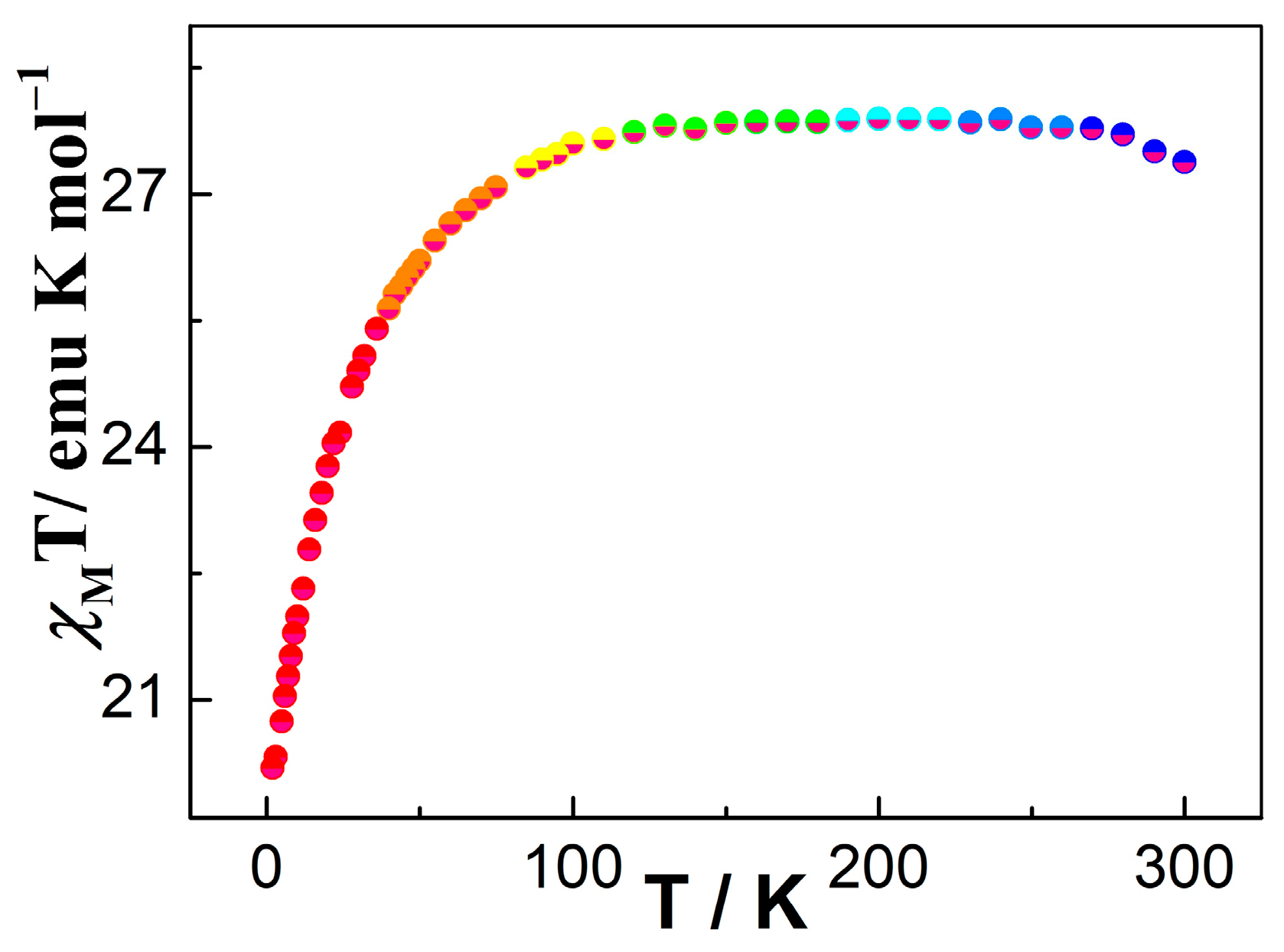
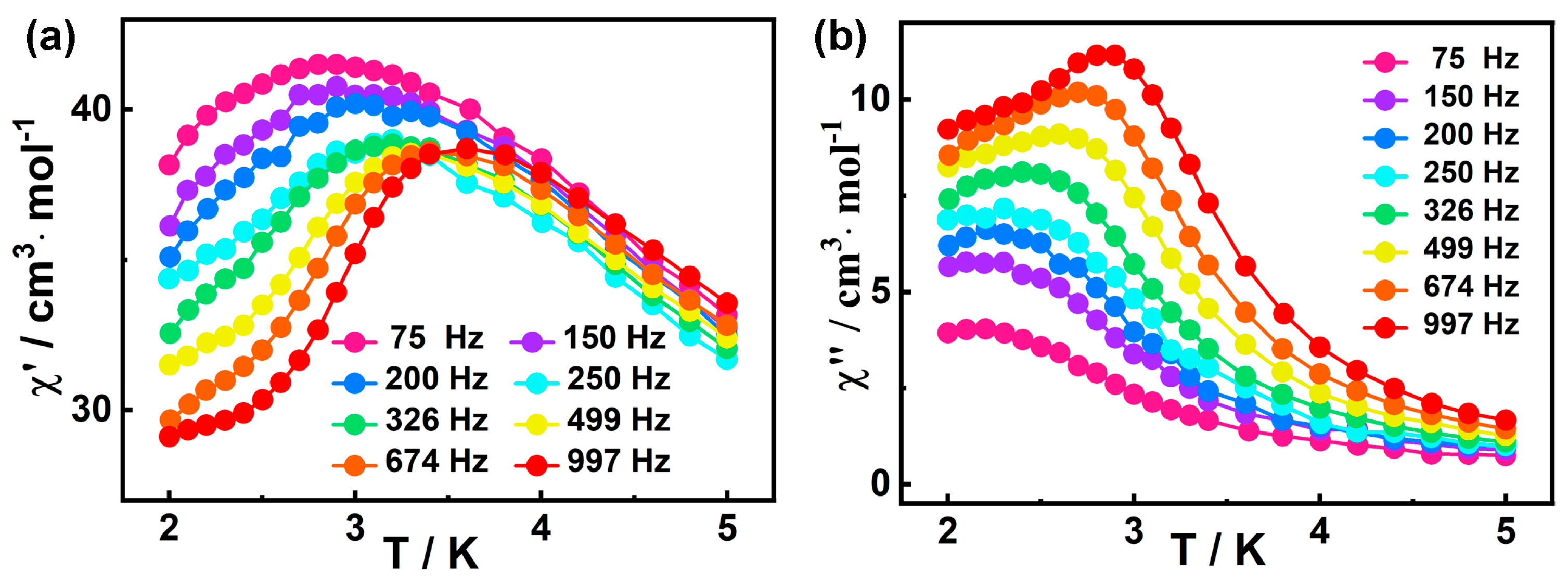
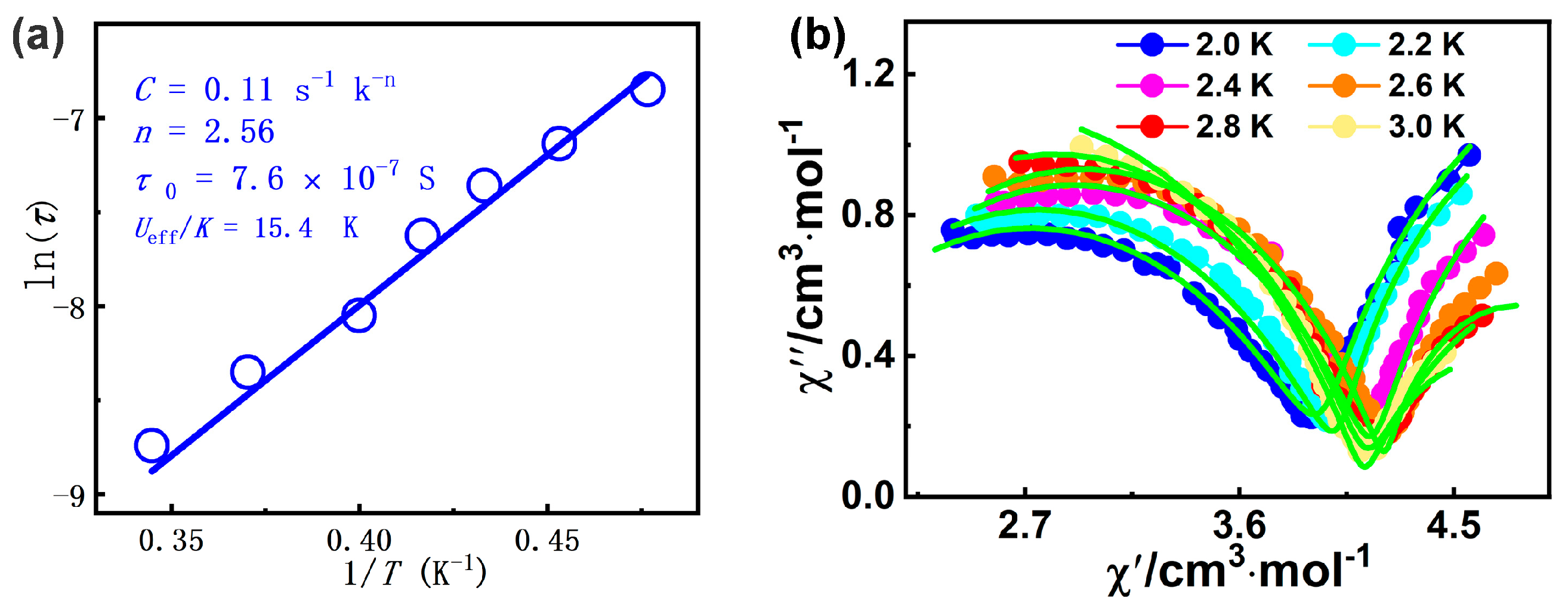
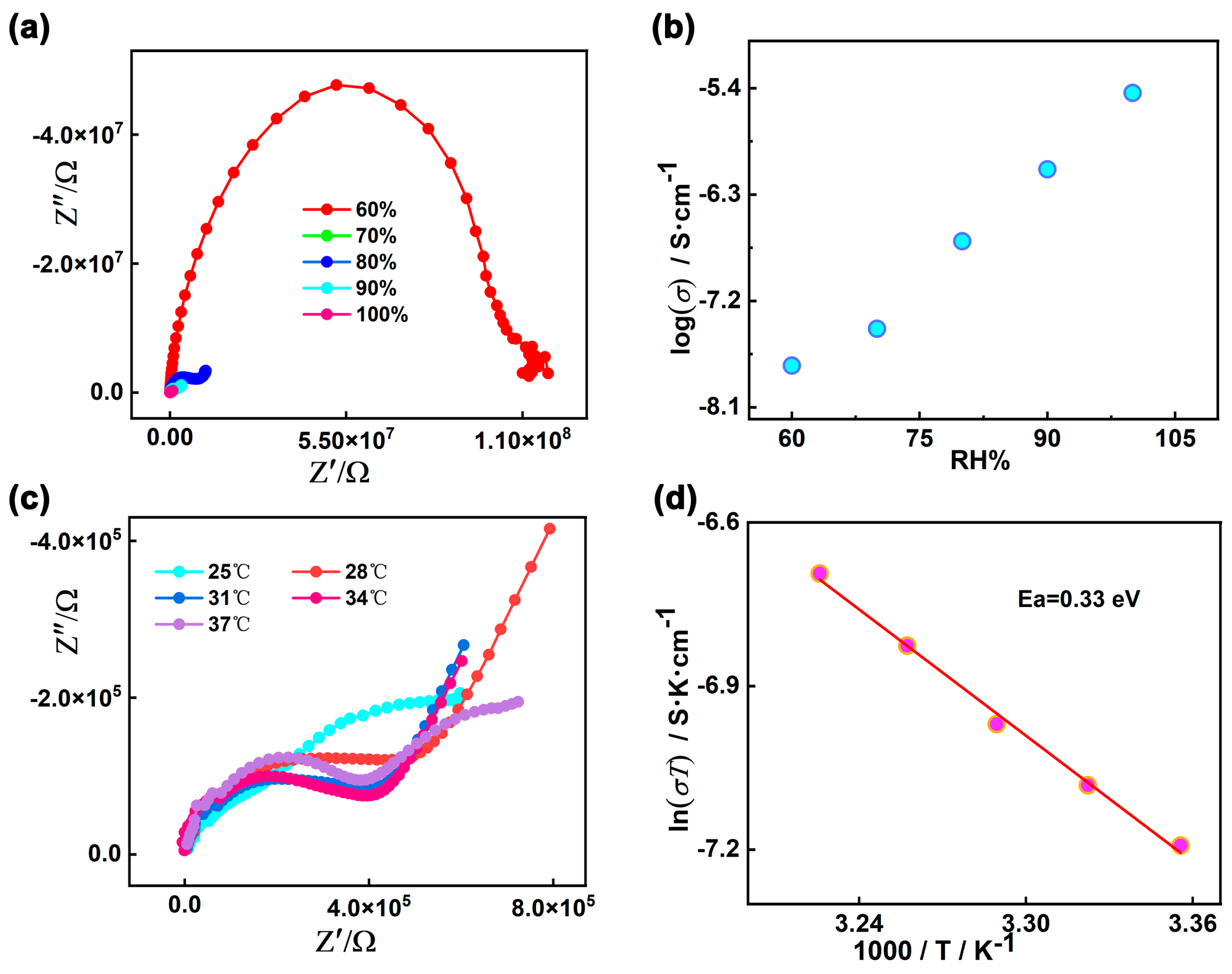
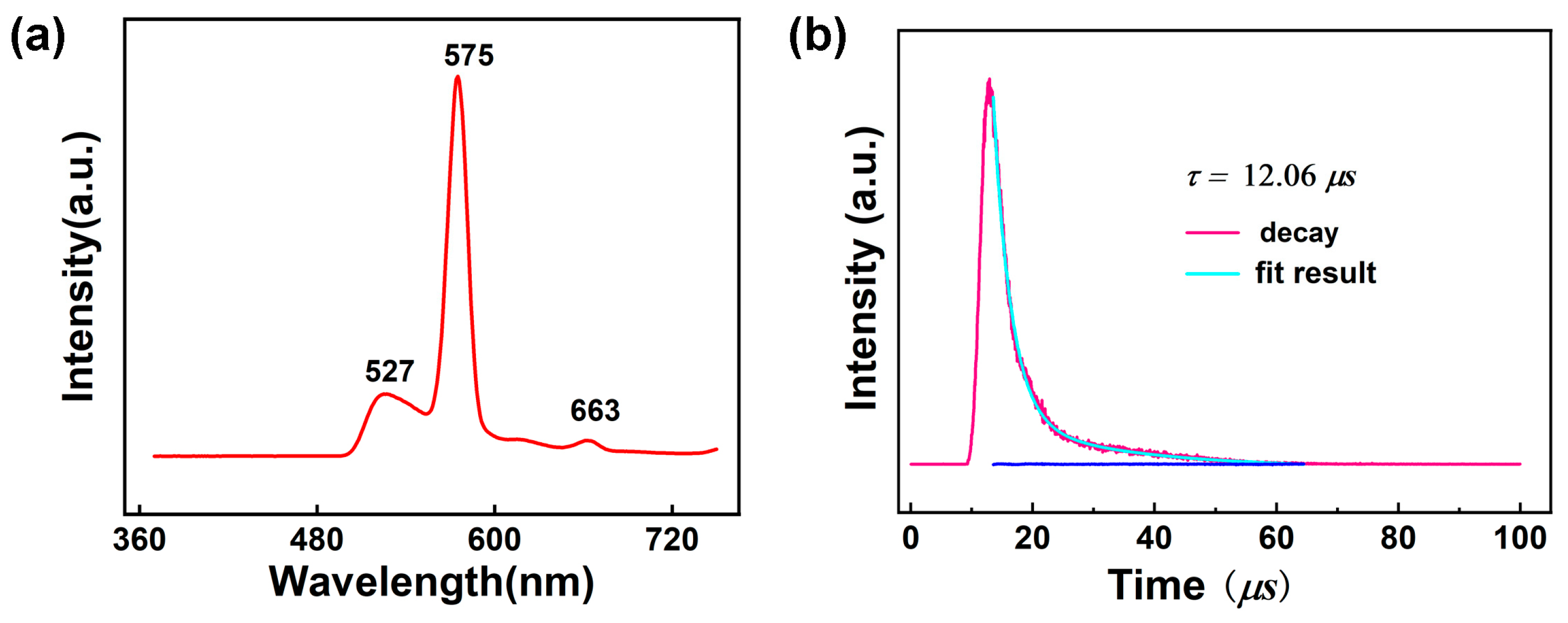
Disclaimer/Publisher’s Note: The statements, opinions and data contained in all publications are solely those of the individual author(s) and contributor(s) and not of MDPI and/or the editor(s). MDPI and/or the editor(s) disclaim responsibility for any injury to people or property resulting from any ideas, methods, instructions or products referred to in the content. |
© 2025 by the authors. Licensee MDPI, Basel, Switzerland. This article is an open access article distributed under the terms and conditions of the Creative Commons Attribution (CC BY) license (https://creativecommons.org/licenses/by/4.0/).
Share and Cite
Lu, Y.; Lei, Y.; Cheng, D.; Long, L.; He, X.; Liu, C.; Wen, H.; Liu, S.; Zhu, S. A Luminescent Proton Conductor Based on Dy2 SMM. Molecules 2025, 30, 1086. https://doi.org/10.3390/molecules30051086
Lu Y, Lei Y, Cheng D, Long L, He X, Liu C, Wen H, Liu S, Zhu S. A Luminescent Proton Conductor Based on Dy2 SMM. Molecules. 2025; 30(5):1086. https://doi.org/10.3390/molecules30051086
Chicago/Turabian StyleLu, Yingbing, Yu Lei, Danpeng Cheng, Lu Long, Xiaoxuan He, Caiming Liu, Herui Wen, Suijun Liu, and Shuidong Zhu. 2025. "A Luminescent Proton Conductor Based on Dy2 SMM" Molecules 30, no. 5: 1086. https://doi.org/10.3390/molecules30051086
APA StyleLu, Y., Lei, Y., Cheng, D., Long, L., He, X., Liu, C., Wen, H., Liu, S., & Zhu, S. (2025). A Luminescent Proton Conductor Based on Dy2 SMM. Molecules, 30(5), 1086. https://doi.org/10.3390/molecules30051086







